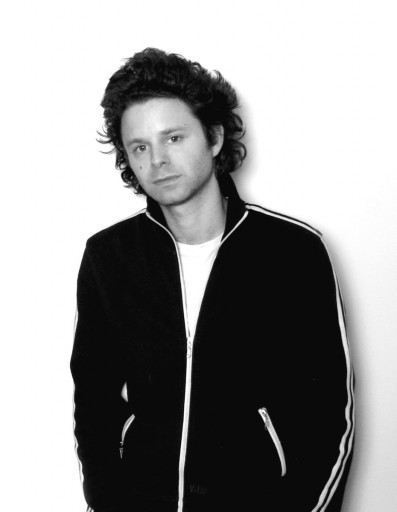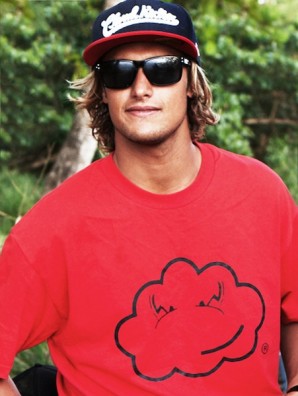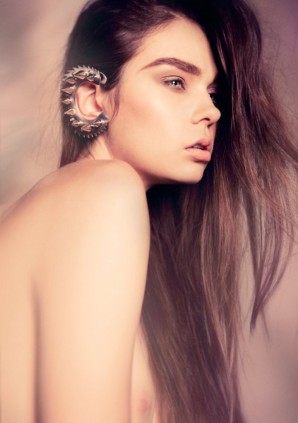After fifteen years at Balenciaga, Nicolas Ghesquière quietly left his post as creative director last November.
Benjamin Shine Interview: Master of Tulle
Benjamin Shine is an award-winning international artist whose work stretches across industries from fashion to product and interior design. Shine has collaborated with fashion heavy-hitters such as Riccardo Tisci while at Givenchy, John Galliano at Maison Margiela, and most recently, he has displayed an installation in the store windows of Bergdorf Goodman on Fifth Avenue in New York City. TWELV had the pleasure of sitting down with the distinguished artist for a discussion on his broader career and awe-inspiring tulle portraits.
1. Where are you from, and what’s the short story of how you began working with tulle?
Well, I’m originally from London. I studied at two different fashion colleges, the Surrey Institute of Art and Design and Central Saint Martens in London. I started to move into using fabric to paint with basically, and I was doing a lot of one piece garment construction, which I loved. I moved into creating pieces that were not on the body but more in a gallery or on a wall as sculptures. This idea of painting with fabric developed and I’m still intrigued by it. I’ve done a lot of product design over the years and invented a lot of things. This recent technique with the tulle– I say recent, but I invented it in 2008 or 2009– has developed beyond an invention or technique, really delving into how the medium can evoke more emotional concepts. I’ve really enjoyed doing that, and the fact that it has brought me back to where it started, back to fashion, is quite ironic but very satisfying too.
2. Where are you located now?
I’m based between London and Australia where I’ve lived for the last ten years, but I’ve recently relocated to New York where I’m working on a whole bunch of projects, possibly for the next two years.
3. For Paris Couture Week last year, your piece for the Margiela Artisanal Collection took everyone by storm. You’ve mentioned previously the challenge in using a walking model as your medium. Was this the first time you worked with movement in this capacity?
It was the first time that I’ve worked on the body– or back on the body– since designing anything as a garment. When I first started talking to John [Galliano] about it, I said, “This will be interesting because we will have a figure walking and the legs are going to be moving. It will be really nice to use that motion, because I’ve not done that before.” And the thing that we wanted to capture was this ethereal quality of it being suspended and almost floating off the coat. It’s not actually connected to the coat. It’s completely independently floating, so that was a challenge. I had been experimenting in Australia with a similar floating technique for an installation just prior to the Margiela piece, so I was able to develop that further.
4. What was the collaborative process like working with John Galliano and the Margiela team?
John’s team first reached out to me through my website which is often how I get requests to collaborate. We met in Paris in October of last year, which was about 4 or 5 months before the show, so we had quite a good amount of time to work out some ideas. He was very quick to identify what he liked about my work and what he wanted to retain in the piece that we were going to do together. I was very happy because we both stumbled upon the same basis, which was to create a piece of tulle on top of a white background. He presented to me a mock up with one of my pieces sort of photoshopped on top of a white coat. From there, he explained more of the concept and the type of face he wanted to portray.
John was incredibly generous and just the talent coming out of him was phenomenal. He sees every detail. We were keeping a record through photographs of the process as it developed, and he would often refer back to a previous photograph where maybe one part of the tulle was doing something slightly different than in the current version. From there, we would try and bring it back or improve it.
5. How many iterations did it take to reach the final piece?
There were lots of samples– probably half a dozen– that were very close to being the final one before we really got it down to the scale and perfection. It was quite a difficult thing to achieve– to make the face still feel organic and natural, instead of just plastered on. The biggest thing was that we had to make it feel like something fresh. There was a real eureka moment where we actually cut the back of the coat and had the classic Margiela idea, inside coming out. It related beautifully to the concept of my work which is so much about trying to shine the light on emotion within, and in a fashion context it’s really great because we’re always focused externally on what something looks like.
6. Do you plan to continue working with garments?
It will most likely be in a slightly different context as opposed to being directly on the body. I love working with the body but not necessarily on it. I like to relate it back to humans and the physical form. That will probably be developing in the coming years, I would say.
7. You use an iron and hand stitching in your technique. Were your methods discovered through experimentation?
I have my fashion background to thank for this technique. I’m not sure I would have ever picked up an iron if I hadn’t studied fashion, and I probably wouldn’t even know what tulle was! While studying at Saint Martins, I would walk down Brick Lane in London to get to the tube to go to school, and there were fabric shops all along the way. One of them was this cheap fabric store that had tulle in bulk from floor to ceiling in every single color. I would walk past that shop every morning and think, “I have to do something with tulle someday. It’s readily available, it’s cheap, and you can do stuff in scale with it.” But it literally did not click for eight years before I even picked it up.
8. So when did the idea click?
In my studio, I saw a crumpled piece of tulle, and I just thought that there are a lot of tones going on here, and it’d be very interesting if these could be arranged in a way that created something recognizable or identifiable. I picked up a piece and started trying to figure it out. I would hold it up in the air and let it fall back down, just trying to imagine, moving it around, and adjusting it into some sort of shape. I picked up some special bonding glue from my fashion days, took the iron, and bonded it, and it held its shape.From there, I realized that was the way I could actually construct these things.
But I decided to add one extra rule, which was to create them out of one piece of tulle. That was what made the challenge and what made it much more interesting and sort of poetic that it was always a single piece of fabric, along with the limitations of that one piece. But I’ve decided to break that rule…
9. It’s fantastic! The tulle seems to defy gravity, almost in a mystical way.
I think I discovered the same sort of sensibility of that material, and in all honesty there are things I’m doing now that I hope will come out in the next two years which I feel encapsulate that idea even more so. I think it will really build on the idea of energy, the flow of energy, and that everything is made of energy. I love that concept.
10. You’re right at the junction of art and fashion. How do you approach the differences in commercialization of those worlds?
Today, I think there’s so much more interest in the artistry of things. In relation to the amount of content that we’re all exposed to, there’s almost an expectation or demand to have better, more artistic work, even at the commercial level. It’s becoming very important even for those commercial brands to be able to offer something interesting to people. Maybe that has to do with the competitive nature of how things are today. I feel the stigma of what is commercial and what is not is reduced, because it’s almost just about the work now. It doesn’t matter even in a commercial setting. All the rules have changed. Now, there’s so many outlets for people to just see it and give real, true feedback through all these social media channels. No one is in charge anymore except the creative people putting it together, publishing it, and seeing what the organic natural response to it is, which is brilliant. It’s great. It’s so liberating.
Having just done this project at Bergdorf Goodman, some might say it’s not good for an artist to exhibit an installation in the windows of a commercial place like that, even though it’s so prestigious in its industry. And I don’t feel that’s true. If the work is strong, it will hold itself and people will recognize it for what it is, regardless of the setting.
11. Collaborating with John Galliano, it seems you quickly saw eye to eye. Was the experience with Bergdorf Goodman any different?
To be honest, it was quite a restricting situation to be in, because Bergdorf has guidelines that they know work. I would often find myself in positions saying, “Well, why don’t we try this.” I think I may have gone through fifteen or twenty concepts that were really extreme actually, but they were not able to go with those. I had to assess what the limitations were and then try to make it work with a concept that I felt really comfortable and enthusiastic about.
One thing was reducing the mannequin number down to one. That was a challenge, but I wanted to retain the minimalism that works well with my work. It wouldn’t be so great to have five mannequins in the window, and they were brilliant in that respect.
I was very happy to go with this concept, which was shining a spotlight on that duality between the spiritual and the superficial. On the one hand, you see something in the window that’s clearly geared toward the superficial and materialistic in terms of the fashion, which is a very well-known brand. But my piece sort of hovering behind acts as a reminder to not lose ourselves, to not lose the sense of ourselves through the seduction of beautiful things.
12. Many of your projects have been connected to philanthropic causes from the fight against AIDS and cancer to elephant conservation. Is this important to you?
Basically, it all goes back to my days studying fashion design. Just the designer’s mentality that you want to create something that is purposeful and do something that is useful. That’s always stayed with me. If I can pair my work or link it to something that will give it some new purpose or value, then I will always try to do that.
13. What should we expect from you in the future?
At the moment, I’m focusing predominantly on a few projects which are going to be taking the concepts further, a bit more out there, which I’m excited about. Some of it will also be going in a slightly more abstract territory as well, a little less on the figurative side. There’s lots of exciting things, and I’ll still be based in New York where the majority of these future projects will be taking shape!
EDITED FOR CLARITY
INTERVIEW BY HOLLIS DE LANEY
PHOTO CREDIT: BENJAMIN SHINE
related posts
Dismay, Danger and Discovery: Nicolas Ghesquière's Untold Story Revealed
IKEMEN #9: LISA LARSSON
IKEMEN (ē´k´mɛn): Japanese Slang
"REALLY, REALLY, RIDICULOUSLY GOOD LOOKING PEOPLE"
IKEMEN #8: HOGAN MCLAUGHLIN
IKEMEN (ē´k´mɛn): Japanese Slang
"REALLY, REALLY, RIDICULOUSLY GOOD LOOKING PEOPLE"
Donna Karan: Million Hearts for Haiti Project
Designer Donna Karan is sending some love down to Haiti.
IKEMEN #7: Salvatore Morale
IKEMEN (ē´k´mɛn): Japanese Slang
"REALLY, REALLY, RIDICULOUSLY GOOD LOOKING PEOPLE"
IKEMEN #6: LUKE CAMPBELL
IKEMEN (ē´k´mɛn): Japanese Slang
"REALLY, REALLY, RIDICULOUSLY GOOD LOOKING PEOPLE"
NICOLA FORMICHETTI: The Art of Deconstruction
Between the time of the confirmation of his departure and the publication of this article, you certainly had time to digest the new news about Nicola Formichetti.
IKEMEN #5: Matthew Scheier
IKEMEN (ē´k´mɛn): Japanese Slang
"REALLY, REALLY, RIDICULOUSLY GOOD LOOKING PEOPLE"
IKEMEN #4: Brian Ermanski
IKEMEN (ē´k´mɛn): Japanese Slang
"REALLY, REALLY, RIDICULOUSLY GOOD LOOKING PEOPLE"
IKEMEN #3: Ekaterina Murphy
IKEMEN (ē´k´mɛn): Japanese Slang
"REALLY, REALLY, RIDICULOUSLY GOOD LOOKING PEOPLE"
IKEMEN #2: Martina Markota
IKEMEN (ē´k´mɛn): Japanese Slang
"REALLY, REALLY, RIDICULOUSLY GOOD LOOKING PEOPLE"
IKEMEN #1: Thanos Samaras
IKEMEN (ē´k´mɛn): Japanese Slang
"REALLY, REALLY, RIDICULOUSLY GOOD LOOKING PEOPLE"
INTERVIEW: HAIM? Never heard of them
Haim (pronounced Hime) are three sisters who put most of their male counterparts to shame. This girls completely own rock 'n' roll.
MUN No.1 Aknari
Makeup artist and beauty expert Munemi Imai's organic nighttime youth serum, No.1 Aknari nourishes and repairs your...
OSCAR DE LA RENTA: AN AMERICAN ICON
For decades now, Oscar de la Renta has been synonymous with pure American luxury, dressing the upper-east side’s ladies who lunch, Hollywood’s red carpet, and first ladies from Jacqueline Kennedy-...
Hunger Games Starlet, Isabelle Fuhrman
今月28(金)日本公開映画「ザ・ハンガー・ゲーム」で決死の殺し合いゲームに挑むクローブ役の15歳の少女、イザベル・ファーマンが本誌に演技や、恋愛について語ってくれた。
What's Zombie Boy Like on the Inside?
Nicola Formichetti’s muse is a walking Mugler moodboard. To Mugler, rare is remarkable. And Genest is nothing if not a celebration of the rare.
Blog Party: WILL PRINCE
Julia Lang is the 25 year old blogger behind www.geeksndfashion.com.
Noritaka Tatehana
Shoe designer Noritaka Tatehana harnesses his secret forces of shoe construction to snag the attention of international fashionistas like Lady Gaga and Daphne Guiness.
Blog Party: Dreamland
We are all different with one distinguishing similarity; we all have that special place in the back of our minds, the “box” as we’d like to name it, in which we store our biggest dreams, greatest...
LA BEAU DUNN
Hollywood it-girl, Beau Dunn, multi-talented model, actress, artist and philanthropist, was born and raised in Beverly Hills, the daughter of a...
Blog Party: Ciao Summer
Joanne Hegarty is a London based blogger and journalist who writes daily posts on how to live stylishly through fashion, interiors and food.
Blog Party: Why I Love The Classics
It’s recently dawned on me how most things in life are cyclical - everything eventually comes back around for a second play; rock n’ roll bands had their day in the 60’s and again in the 90’s;...
A Strong Man: Scott Lipps
As CEO and founder of one of the world’s most prestigious modeling agencies, the orchestrator behind a premier fashion blog, the star of an E reality TV show, and the drummer...
Pro-Surfer Andres Carreras Makes a Splash with new Sponsor, Cloud Kicker
J. Andres Carreras was born in 1991 and is a pro surfer from Aguadilla, Puerto Rico. Though only 21 years of age, Carreras has been surfing for 9 years.
Blog Party: You don’t wear your Clothes, you wear your Attitude.
...
Blog party: There is no such thing as your instinct
Julia Lang is the 25 year old blogger behind www.geeksndfashion.com.
Blog party: Nautical but Nice
My name is Joanne Hegarty and I write the blog, Ballet Pumps And Roses, which has daily posts on living stylishly through...
blog party: Hidden Treasures
Nayla , Noor and Rawdah Al Naimi are the three sisters behind the blogs Cocoa Butter, Celebrities Style and Unbreakable Diamond.
Mischa Barton – The Full Interview with TWELV mag Issue: 001
Mischa Barton – The Full Interview.
Issue: 001
blog party: One, Two, THREE FLOOR!
Julia Lang is the 25 year old blogger behind www.geeksndfashion.com.
Good Ol’ Georgia Boy
Sean O’Pry, Fashion’s hottest male model get’s a dirty makeover and muses about the simple life.
DJ-ing his Way From England to L.A.: Zen Freeman Opens up to TWELV About his Latest Endeavors
“A celebrity in his own right, [Zen Freeman] DJs and promotes for the hottest events and venues worldwide.
A Shining Example: Lauren Bush On the Noble Mission of Curing Hunger Through Fashion.
When it comes to using fashion as a force for profound humanitarian good, Lauren Bush has cornered the market.
blog party: Paris Gone Wild
Eric Waroll is the fashion editor and blogger of EricWaroll.com. At just 21, he is quickly becoming a significant part of the young Paris fashion scene.














































